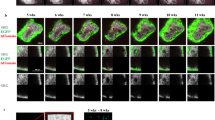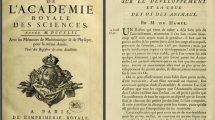Abstract
A new method is presented by which an increase in cortical bone mass over time can be determined from morphometric analysis of sections of undemineralized bone under the optical microscope. The method depends on the long-duration, continuous labeling of new bone by tetracycline during the experimental period. In addition, a comparison of the rates of new bone formation in the control and experimental periods can be made by administering a different fluorescent molecule during the control period. All bone deposited during the control period is thus labeled with a different color. By knowing the differences in rates of formation between control and experimental periods, additional insight is gained into the mechanism by which the increase in bone mass is produced.
Experimental studies on the influence of growth hormone on the cortical skeletal mass in adult dogs of both sexes are presented as examples of the use of this method.
Résumé
Une nouvelle méthode d'analyse morphométrique au microscope optique de coupes non déminéralisées d'os, qui permet de déterminer l'augmentation de la masse d'os cortical en fonction du temps, est présentée. Cette méthode est basée sur le marquage continu et de longue durée de l'os néoformé par la tétracycline pendant la période expérimentale. En outre, on peut effectuer une comparaison entre la durée de formation d'os nouveau pendant des périodes de contrôle et d'expérience, en administrant une molécule fluorescente différente pendant la période témoin. L'os déposé, pendant cette dernière phase, est ainsi marqué dans une couleur différente. En connaissant les différences de durée de formation entre les deux périodes, on peut préciser le mécanisme d'augmentation de la masse osseuse.
Des études expérimentales sur l'influence de l'hormone de croissance sur la masse corticale squelettique de chiens adultes des deux sexes sont présentées comme des exemples de cette méthode.
Zusammenfassung
Es wird eine neue Methode zur Messung der Zunahme der kortikalen Knochenmasse in Funktion der Zeit beschrieben. Dies geschieht durch morphometrische Analyse von Schnitten undemineralisierten Knochens unter dem Mikroskop. Die Methode stützt sich auf die kontinuierliche Langzeitmarkierung von neuem Knochen mit Tetracyclin während der Dauer des Experimentes. Zusätzlich kann die Geschwindigkeit der Knochenzunahme während der Kontrollperiode mit derjenigen während des Experimentes verglichen werden, indem während der Kontrollperiode eine andere fluoreszierende Substanz verabreicht wird. Somit wird aller Knochen, der während der Kontrollperiode abgelagert wird, in einer verschiedenen Farbe markiert. Die Kenntnis der Unterschiede der Bildungsgeschwindigkeiten zwischen der Kontroll- und der Experimentier-Periode ermöglicht zusätzliche Einblicke in den Mechanismus, durch welchen die Zunahme der Knochenmasse herbeigeführt wird.
Als Beispiel für die Anwendung dieser Methode werden experimentelle Untersuchungen über den Einfluß des Wachstumshormones auf die kortikale Skelettmasse bei erwachsenen Hunden beiden Geschlechts angegeben.
Similar content being viewed by others
References
Chalkley, H. W.: Method for quantitative morphologic analysis of tissues. J. nat. Cancer Inst.4, 47–53 (1943).
Frost, H. M., Villanueva, A. R.: Measurement of osteoblastic activity in diaphyseal bone. Stain Technol.35, 179–189 (1960).
Garn, S. M., Rohmann, C. G., Wagner, B.: Bone loss as general phenomenon in man. Fed. Proc.26, 1729–1736 (1967).
Harris, W. H., Haywood, E. A., Lavorgna, J., Hamblen, D. L.: Spatial and temporal variations in cortical bone formation in dogs. J. Bone Jt Surg. A50, 1118–1128 (1968).
Hennig, A.: A critical survey of volume and surface measurement in microscopy. Zeiss-Werkz.30, 78–87 (1958).
Mack, P. B.: Radiographic bone densitometry. In: Progress in development of methods of bone densitometry. NASA-SP-64, 31–46 (1965).
Meema, H. E., Bunker, M. L., Meema, S.: Loss of compact bone due to menopause. Obst. and Gynec.26, 333–343 (1965).
—, Meema, S.: Cortical bone mineral density versus cortical thickness in the diagnosis of osteoporosis: A roentgenologic-densitometric study. J. Amer. Geriat. Soc.17, 120–141 (1969).
Morgan, D. B., Spiers, F. W., Pulvertaft, C. N., Fourman, P.: The amount of bone in the metacarpal and the phalanx according to sex and age. Clin. Radiol.18, 101–108 (1967).
Nordin, B. E. C., Barnett, E., Smith, D. A., Anderson, J.: Measurement of cortical bone volume and lumbar spine density. In: Progress in development of methods of bone densitometry. NASA-SP-64, 21–30 (1965).
Schraer, H.: Quantitative radiography of the skeleton in living systems. In: Progress in development of methods in bone densitometry. NASA-SP-64, 11–20 (1965).
Sorenson, J. A., Cameron, J. R.: A reliable in vivo measurement of bone mineral content. J. Bone Jt Surg. A49, 481–497 (1967).
Author information
Authors and Affiliations
Rights and permissions
About this article
Cite this article
Harris, W.H., Weinberg, E.H. Microscopic method of measuring increases in cortical bone volume and mass. Calc. Tis Res. 8, 190–196 (1971). https://doi.org/10.1007/BF02010137
Received:
Accepted:
Issue Date:
DOI: https://doi.org/10.1007/BF02010137




